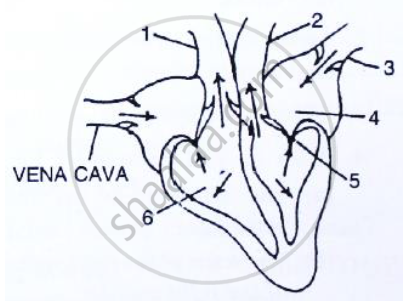Advertisements
Advertisements
प्रश्न
Given alongside is a diagram of the external features of the heart.
(i) Name the parts ‘1’ to ‘7’.
(ii) What happens if the coronary artery gets an internal clot?
(iii) Which type of blood does part ‘5’ carry?
(iv) Mention one structural difference between part ‘5’ and ‘4’.
उत्तर
(i)
1. Aorta
2. Left atrium
3. Left ventricle
4. Dorsal aorta
5. Inferior vena cava
6.Superior vena cava
7. Pulmonary artery.
(ii) If the coronary artery gets an internal clot, the corresponding part of the heart does not get its blood supply. This will result in loss of contraction or even death of the cardiac cells resulting in a heart attack or coronary arrest which may prove to be fatal.
(iii) Part ‘5’ which is the inferior vena cava carries deoxygenated blood which is rich in CO2 and metabolic wastes.
(iv) Part ‘5’ is more muscular and the lumen is narrow while part ‘4’ is less muscular and the lumen is wider.
APPEARS IN
संबंधित प्रश्न
The diagram given alongside represents the human heart in one phase of its activity. Study the same and then answer the question that follow:

Name the phase.
Name the following:
The first heart sound.
Refer to fig. 7.3 and answer the following questions:

(i) Impure blood is received by
(ii) Which chamber has thickest wall
(iii) Function of bicuspid value
(iv) Function of tricuspid value
Name the Following
The study of blood vascular system including arteries, veins and heart.
State the Function: Tricuspid valve
Which of the following has thickest wall?
The normal human heartbeat rate is about ______ time per minute.
The heart is surrounded by a double-layered membrane called ______.
The walls of the heart is made up of ______.
Give the meaning of pacemaker.
